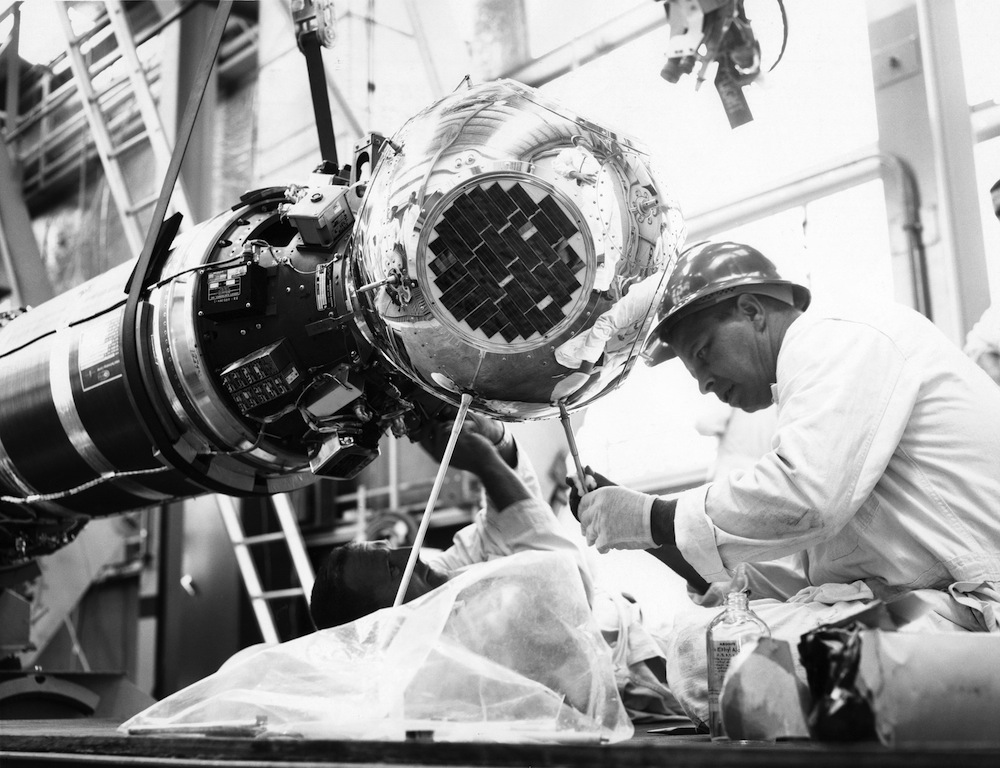|
SOLRAD 7B
SOLRAD 7B was the eighth solar X-Ray monitoring satellite in the SOLRAD series and the fifth to successfully orbit the Earth. It was launched via Thor Augmented Delta-Agena D along with seven other satellites on March 9, 1965. The satellite provided continuous coverage of the Sun during the International Quiet Solar Year from March through October 1965. History The SOLRAD science satellite program was conceived in 1958 to observe the Sun in the X-ray spectrum. It was quickly combined, to provide civilian cover (launches being unclassified at that time), with the concurrently conceived United States Naval Research Laboratory's GRAB satellite project, which would collect information on foreign radars and communications installations. There were five SOLRAD/GRAB missions between 1960 and 1962, with the scientific SOLRAD experiments sharing satellite space with GRAB's intelligence payload. Two of the missions were successful. In 1962, all U.S. overhead reconnaissance projects wer ... [...More Info...] [...Related Items...] OR: [Wikipedia] [Google] [Baidu] |
Solar Corona
A corona ( coronas or coronae) is the outermost layer of a star's atmosphere. It consists of plasma. The Sun's corona lies above the chromosphere and extends millions of kilometres into outer space. It is most easily seen during a total solar eclipse, but it is also observable with a coronagraph. Spectroscopic measurements indicate strong ionization in the corona and a plasma temperature in excess of , much hotter than the surface of the Sun, known as the photosphere. The word ''corona'' is , in turn derived . History In 1724, French-Italian astronomer Giacomo F. Maraldi recognized that the aura visible during a solar eclipse belongs to the Sun, not to the Moon. In 1809, Spanish astronomer José Joaquín de Ferrer coined the term 'corona'. Based in his own observations of the 1806 solar eclipse at Kinderhook (New York), de Ferrer also proposed that the corona was part of the Sun and not of the Moon. English astronomer Norman Lockyer identified the first element unknow ... [...More Info...] [...Related Items...] OR: [Wikipedia] [Google] [Baidu] |
Solar Cycle
The solar cycle, also known as the solar magnetic activity cycle, sunspot cycle, or Schwabe cycle, is a nearly periodic 11-year change in the Sun's activity measured in terms of variations in the number of observed sunspots on the Sun's surface. Over the period of a solar cycle, levels of solar radiation and ejection of solar material, the number and size of sunspots, solar flares, and coronal loops all exhibit a synchronized fluctuation from a period of minimum activity to a period of a maximum activity back to a period of minimum activity. The magnetic field of the Sun flips during each solar cycle, with the flip occurring when the solar cycle is near its maximum. After two solar cycles, the Sun's magnetic field returns to its original state, completing what is known as a Hale cycle. This cycle has been observed for centuries by changes in the Sun's appearance and by terrestrial phenomena such as aurora but was not clearly identified until 1843. Solar activity, driven ... [...More Info...] [...Related Items...] OR: [Wikipedia] [Google] [Baidu] |
OSCAR 3
OSCAR 3 (a.k.a. OSCAR III) is the third amateur radio satellite launched by Project OSCAR into Low Earth Orbit. OSCAR 3 was launched March 9, 1965 by a Thor-DM21 Agena D launcher from Vandenberg Air Force Base, Lompoc, California. The satellite, massing , was launched piggyback with seven United States Air Force satellites. Though the satellite's active life was limited to sixteen days due to battery failure, OSCAR 3 relayed 176 messages from 98 stations in North America and Europe during its 274 orbit life-time -- the first amateur satellite to relay signals from Earth. As of 2022, it is still in orbit. Project OSCAR Project OSCAR Inc. was started in 1960 by members of the TRW Radio Club of Redondo Beach, California as well as persons associated with Foothill College to investigate the possibility of putting an amateur satellite in orbit. Project OSCAR was responsible for the construction of the first Amateur Radio Satellites: OSCAR 1, launched from Vandenberg AFB in California ... [...More Info...] [...Related Items...] OR: [Wikipedia] [Google] [Baidu] |
SECOR
SECOR (Sequential Collation of Ranges) was a series of small United States Armed Forces satellites launched in the 1960s for geodesy measurements that precisely determined the locations of points on the Earth's surface, particularly of isolated islands in the Pacific Ocean. This data allowed for improved global mapping and precise positioning of ground stations for other satellites. Any SECOR satellite could be linked to four mobile ground stations: three were placed in accurately determined known locations, and a fourth one was placed in an unknown location. By measuring a satellite's distance from the three known stations, its position in space was determined. Then, the distance between the unknown ground station and the previously determined satellite's position was used to compute the unknown ground station's coordinates. This process was repeated many times, to enhance the accuracy of the measurement. Once the unknown station's position was accurately determined, it became ... [...More Info...] [...Related Items...] OR: [Wikipedia] [Google] [Baidu] |
ELINT
Signals intelligence (SIGINT) is intelligence-gathering by interception of '' signals'', whether communications between people (communications intelligence—abbreviated to COMINT) or from electronic signals not directly used in communication (electronic intelligence—abbreviated to ELINT). Signals intelligence is a subset of intelligence collection management. As classified and sensitive information is usually encrypted, signals intelligence in turn involves the use of cryptanalysis to decipher the messages. Traffic analysis—the study of who is signaling whom and in what quantity—is also used to integrate information again. History Origins Electronic interceptions appeared as early as 1900, during the Boer War of 1899–1902. The British Royal Navy had installed wireless sets produced by Marconi on board their ships in the late 1890s, and the British Army used some limited wireless signalling. The Boers captured some wireless sets and used them to make vital tr ... [...More Info...] [...Related Items...] OR: [Wikipedia] [Google] [Baidu] |




